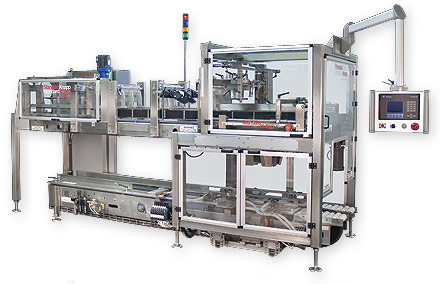White Paper: Six Factors to Consider When Selecting a Case Packer

There are many styles of case packers available including drop packers, rotary packers, wraparound packers, mechanical soft placement packers, robotic packers, side load packers, and bottom load packers. The need for a new packer may simply be to replace an aging, high maintenance machine, or it may be driven by new packages, higher line speeds, efficiency initiatives, or new packaging requirements. The following factors provide some basic considerations that can be used in the process of selecting a case packer.
- Type of Case:
The starting point for determining the optimal case packer is to identify the type of case for the packaging application. While dozens of case types exists, a few of the more common are: 1) top load RSC (regular slotted container); 2) side load RSC or end load RSC; and 3) wraparound. Often case type is predetermined, as the product is already in the market and product marketers or retailers may insist on maintaining the status quo. For example, liquor stores strongly prefer RSC top load cases over wraparound, as the RSC case has utility for customers who buy several bottles. However, when case type is not predetermined, the best case should protect the primary container while economizing corrugated. Top load RSC cases offer the best stacking strength and are ideal for compressible products such as pouches, large PET bottles, personal care and trigger bottles. Top load cases also allow for partitions to increase stacking strength or to minimize bottle to bottle contact. Where bottle or product protection is not as critical, wraparound cases are a good alternative and can sometimes require fewer square inches of corrugated in comparison to RSC cases. - Primary Product:
The type of container (or primary product) will often influence the packer type. Expensive beverages such as top shelf spirits require a partitioned case, which will usually dictate a drop packer or soft placement packer. Side load case packers are often used for boxed items like dry pasta or bars of soap because pushing the product from the side is easier then top loading. Larger items, such as #10 metal food cans or wheels of cheese work well in wraparound style packers. For the larger products such as outdoor grills, bottom load packers are most gentle on the primary product, as the case is pushed over the product. - Line Speeds:
The rate of the line, as dictated by the upstream filling or processing is a key factor when selecting the correct packer. Selecting a packer with enough speed is important, however too much speed may be an unnecessary cost. Speed usually costs money and packers can range from $50,000 to $750,000. Generally speaking, speeds below 20 cases per minute can be done effectively with side load packers, bottom load or robotic packers. For speeds from 20 to 35 cases per minute, drop packers or intermittent motion wraparound packers are good choices. Soft placement packers, servo drop packers, rotary packers, and continuous motion wraparound packers are able to handle speeds above 35 cases per minute. Carefully consider a packers infeed and laning technology, as this becomes critical at higher speeds. - Machine Load:
It is essential when selecting a case packer to ensure that it is designed for the job and the best way to determine this is to see one running a similar application. Consider factors such as weight of the product being handled, true production rates, and runtime per week. Is the filled case weight 50 pounds with a production demand of 24 hrs/day x 7 days/week? If so, this requires a truly robust solution and although the initial cost may be higher, the reduced life cycle costs will justify the initial investment. Find a supplier who has a proven solution for the specific application requirements. - Floor Space:
Plant floor space is a premium and some solutions can take up more space than others. Intermittent motion wraparounds are usually space efficient versus alternatives; however continuous motion wraparounds are usually very wide and long. Drop packers and soft placement packers offer narrow profiles with flexible layouts (inline, counter-flow, or right angle). Although robots can be space efficient, consider the guarding requirements in the layout. - Changeover and Flexibility:
In this area, all machines are not created equal. Robotic Packers are best in this category with quick changeovers. Some can even be partially automated. Drop Packers come in second and have the benefit of easy and simple changeover. Rotary packers and soft placement packers fall somewhere in the middle, as there are more change parts to handle. Wraparound packers are usually the least flexible, in particular for new packages that are added in the aftermarket.
Consider all of the factors above when selecting a case packer. Get in the field to see similar applications running and select the right tool for the job. Everybody has a budget, but in most cases, the value of having good line efficiencies and low life cycle costs will far outweigh the initial investment. Don’t skimp.
Copyright © 2024 Standard-Knapp, Inc.
Privacy | Accessibility
Transparency in Coverage
Sales: (860) 342-1100
Fax: (860) 342-1557